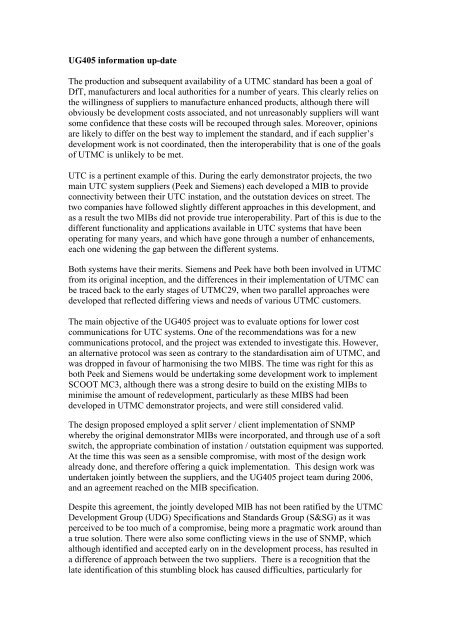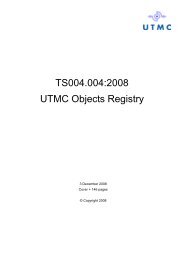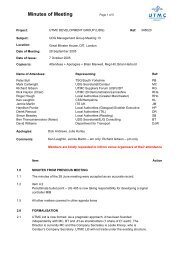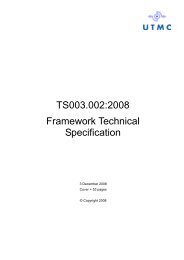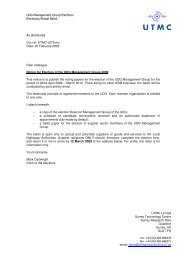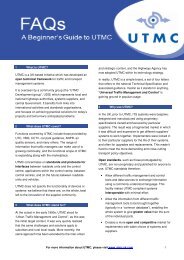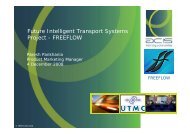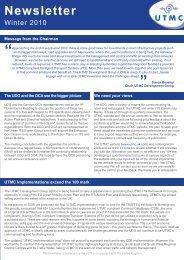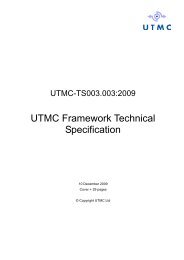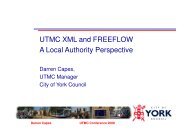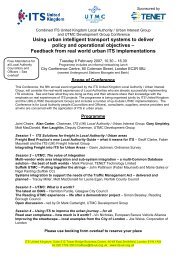UG405 information up-date - UTMC
UG405 information up-date - UTMC
UG405 information up-date - UTMC
You also want an ePaper? Increase the reach of your titles
YUMPU automatically turns print PDFs into web optimized ePapers that Google loves.
<strong>UG405</strong> <strong>information</strong> <strong>up</strong>-<strong>date</strong><br />
The production and subsequent availability of a <strong>UTMC</strong> standard has been a goal of<br />
DfT, manufacturers and local authorities for a number of years. This clearly relies on<br />
the willingness of s<strong>up</strong>pliers to manufacture enhanced products, although there will<br />
obviously be development costs associated, and not unreasonably s<strong>up</strong>pliers will want<br />
some confidence that these costs will be reco<strong>up</strong>ed through sales. Moreover, opinions<br />
are likely to differ on the best way to implement the standard, and if each s<strong>up</strong>plier’s<br />
development work is not coordinated, then the interoperability that is one of the goals<br />
of <strong>UTMC</strong> is unlikely to be met.<br />
UTC is a pertinent example of this. During the early demonstrator projects, the two<br />
main UTC system s<strong>up</strong>pliers (Peek and Siemens) each developed a MIB to provide<br />
connectivity between their UTC instation, and the outstation devices on street. The<br />
two companies have followed slightly different approaches in this development, and<br />
as a result the two MIBs did not provide true interoperability. Part of this is due to the<br />
different functionality and applications available in UTC systems that have been<br />
operating for many years, and which have gone through a number of enhancements,<br />
each one widening the gap between the different systems.<br />
Both systems have their merits. Siemens and Peek have both been involved in <strong>UTMC</strong><br />
from its original inception, and the differences in their implementation of <strong>UTMC</strong> can<br />
be traced back to the early stages of <strong>UTMC</strong>29, when two parallel approaches were<br />
developed that reflected differing views and needs of various <strong>UTMC</strong> customers.<br />
The main objective of the <strong>UG405</strong> project was to evaluate options for lower cost<br />
communications for UTC systems. One of the recommendations was for a new<br />
communications protocol, and the project was extended to investigate this. However,<br />
an alternative protocol was seen as contrary to the standardisation aim of <strong>UTMC</strong>, and<br />
was dropped in favour of harmonising the two MIBS. The time was right for this as<br />
both Peek and Siemens would be undertaking some development work to implement<br />
SCOOT MC3, although there was a strong desire to build on the existing MIBs to<br />
minimise the amount of redevelopment, particularly as these MIBS had been<br />
developed in <strong>UTMC</strong> demonstrator projects, and were still considered valid.<br />
The design proposed employed a split server / client implementation of SNMP<br />
whereby the original demonstrator MIBs were incorporated, and through use of a soft<br />
switch, the appropriate combination of instation / outstation equipment was s<strong>up</strong>ported.<br />
At the time this was seen as a sensible compromise, with most of the design work<br />
already done, and therefore offering a quick implementation. This design work was<br />
undertaken jointly between the s<strong>up</strong>pliers, and the <strong>UG405</strong> project team during 2006,<br />
and an agreement reached on the MIB specification.<br />
Despite this agreement, the jointly developed MIB has not been ratified by the <strong>UTMC</strong><br />
Development Gro<strong>up</strong> (UDG) Specifications and Standards Gro<strong>up</strong> (S&SG) as it was<br />
perceived to be too much of a compromise, being more a pragmatic work around than<br />
a true solution. There were also some conflicting views in the use of SNMP, which<br />
although identified and accepted early on in the development process, has resulted in<br />
a difference of approach between the two s<strong>up</strong>pliers. There is a recognition that the<br />
late identification of this stumbling block has caused difficulties, particularly for
Peek. However, both s<strong>up</strong>pliers remain committed to the goals of <strong>UTMC</strong>, and are<br />
willing to work to develop a single UTC MIB despite the abortive costs incurred to<br />
<strong>date</strong>.<br />
Siemens and Peek met in early May to review the <strong>UG405</strong> MIB to assess what scope<br />
existed to develop a MIB that would be less of a compromise between the two<br />
different approaches. UDG also met in May, and discussed the outcome of the<br />
meeting and also the way forward with regard to adopting a revised MIB as a <strong>UTMC</strong><br />
standard. Siemens and Peek met again at the end of May to review a number of<br />
technical issues, and to establish a further series of meetings to conclude this work.<br />
While the final outcome cannot be predicted, work is proceeding on defining a new<br />
MIB, and it is hoped that a revised MIB will be available in time for the <strong>UTMC</strong><br />
conference in November.


